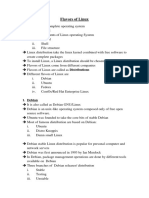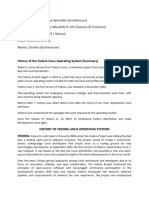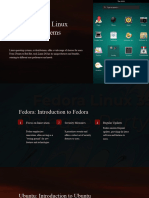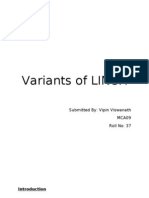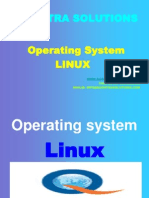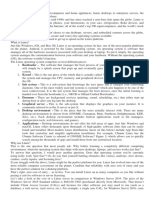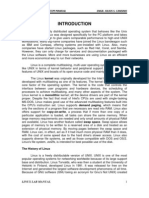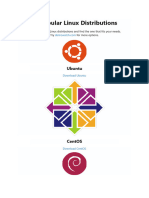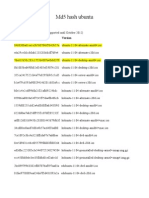Variants of Linux OS.
One of the most confusing things for the newcomer to Linux is how many
distributions, or versions, of the operating system there are. Ubuntu is the one most
people have heard of, but there are hundreds of others as well, each offering some
variant on the basic Linux theme.
What follows, then, is a roundup of sorts of the top 10 Linux distributions today.
1. Ubuntu
Ubuntu has become the poster child for Linux these days, and no wonder--it's the
most popular distro by far, garnering more than 2,200 hits per day on the
Distrowatch site alone, compared with some 1,400 for Fedora, the No. 2 contender.
Ubuntu is actually a relatively late arrival on the Linux scene, having been
announced in just 2004, but it's more than made up for that shorter history. Founded
by South African millionaire Mark Shuttleworth, Canonical--the company behind
Ubuntu--for many years shipped Ubuntu CDs to interested users for free, thus
speeding its market penetration.
Ubuntu is based on Debian (see below) and includes well-known apps such
as Firefox and OpenOffice.org. It has a predictable, six-month release schedule, with
occasional Long Term Support (LTS) versions that are supported with security for to
five years.Ubuntu is also notable for its ease of use and its inclusion of a migration
assistant for Windows users and support for the latest technologies. Version 10.10 of
Ubuntu--also known as Maverick Meerkat--will include a multitouch and gesture
stack. The final iteration of that version is due out next month.
It's also worth understanding that Ubuntu is available in various remixes and spin-off
sub-distros targeted at specific niches, such as Kubuntu, Xubuntu and Lubuntu. Most
of these differ primarily by offering a desktop environment other than Ubuntu's
standard GNOME.
2. Fedora
Fedora is the free version of Red Hat, whose RHEL (Red Hat Enterprise Linux) has
been a commercial product since 2003. Because of that close connection, Fedora is
particularly strong on enterprise features, and it often offers them before RHEL does.
Fedora also offers a six-month release schedule, and its security features are
excellent. While some have viewed it as a cutting-edge distro for the Linux
"hobbyist," I think improvements over the years and widespread popularity have
combined to make it a good choice for newer Linux users as well.
�3. Linux Mint
Currently in Distrowatch's third spot in popularity, Linux Mint is an Ubuntu-based
distro that was just launched in 2006. The operating system adds to Ubuntu with its
own, distinct desktop theme and a different set of applications; also unique to the
distro are a variety of graphical tools for enhanced usability, such as mintDesktop for
configuring the desktop environment, mintInstall for easier software installation and
mintMenu for easier navigation.
Mint enjoys a well-deserved reputation for ease of use, so it's another good one for
beginning users. It also includes some proprietary multimedia codecs that are often
absent from larger distributions, thereby enhancing its hardware compatibility. Mint
doesn't have a fixed release schedule, but typically a new version comes out shortly
after each stable Ubuntu release.
4. openSUSE
With some 1,200 hits per day on Distrowatch, openSUSE holds the No. 4 spot in
popularity on the site and is also the foundation for Novell's SUSE Linux Enterprise
Desktop and SUSE Linux Enterprise Server products.
The package's administration utility, YaST, is widely acknowledged as one of the
best, and its boxed edition comes with some of the best printed documentation you'll
find for any distro. I'd say openSUSE rates a "medium" on difficulty level.
5. PCLinuxOS
Rather than GNOME, PCLinuxOS uses the KDE desktop environment and is
essentially a lighter-weight version of Mandriva (see below). With good support for
graphics drivers, browser plugins and media codecs, PCLinuxOS can be a good
choice for beginners. Its release cycle can be erratic, though, and there is also no
64-bit version of the software.
6. Debian
Dating back to 1993, Debian is currently known as one of the most well-tested and
bug-free distros available today. Though it serves as the foundation for Ubuntu, most
view Debian as a distro best-suited for those experienced with Linux. The distro uses
all open-source components, which is a good thing, but means it can be more
difficult to achieve compatibility with proprietary code such as wireless network
drivers. Debian also has a relatively slow release cycle, with stable ones coming out
every one to three years.
�7. Mandriva
Formerly known as Mandrake, Mandriva is notable for its cutting-edge software,
excellent administration suite and 64-bit edition. It was also the first major distribution
to jump on the netbook bandwagon with out-of-the box support. Nevertheless,
Mandriva has been struggling lately as a result of some controversial decisions
made by its French maker. It recently restructured, with the result that some view the
future of its community version as uncertain.
8. Sabayon/Gentoo
Italian Sabayon is essentially a LiveCD version of Gentoo, which is known for
allowing users to individually optimize each component. Both are considered
advanced Linux distributions aimed primarily at experienced users.
9. Arch Linux... plus Slackware
Arch is another package aimed primarily at experienced users interested in tweaking
and optimizing their systems. Though not in the top 10 currently, Slackware is
similarly oriented toward Linux gurus.
10. Puppy Linux... plus DSL
Last on Distrowatch's top 10 currently is Puppy Linux, a compact distro that's ideal
for older hardware and situations where computing resources are minimal. (Damn
Small Linux, incidentally, is similar.) Though it has a small footprint, Puppy is still full-
featured and includes a variety of configuration and application installation wizards.
The whole OS is small enough to run directly from system RAM, so applications start
quickly and respond to user input instantly.




